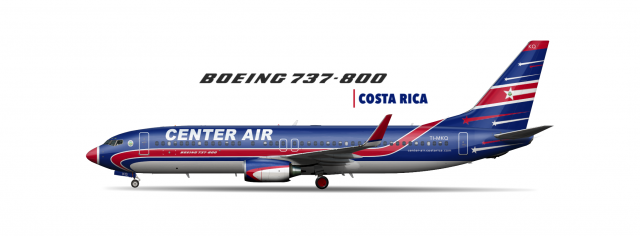BOEING 737-800
- Owner: Fab_Karayou (View all images and albums)
- Uploaded: Aug 16 2022 06:29 PM
- Views: 646
- Album Center Air

The year 2000 is marked by an evolution for Center Air. This year, it is not far from two years that the new generation of 737 entered in service. It is about the versions 600 / 700 / 800 / 900 of the American manufacturer.
Following a satisfactory start-up, Center Air approaches Boeing in order to place an order for new aircraft.
Already holder of several 737 in version 200 and 400, the Costa Rican company wishes to increase its fleet with larger planes, able to transport more passengers, but also to be able to propose more distant destinations.
Several weeks of negotiations have taken place. The fleet's director of operations even made a trip to Seattle to see these new versions of the 737.
On November 03, 2000 an order for 38 aircraft was finally placed. After having settled the payment and delivery terms, Center Air officially announced on November 18 its order for 8 737-700 and 30 737-800 with an option for 12 other 800.
The first 737-800 to fly for Center Air entered service on May 7, 2001 after being flown from Seattle on May 3 of the same year. Due to the high flight rates, Center Air quickly became the "Fleet Leader" in Central and South America in terms of the number of aircraft and the number of flights performed on this type of aircraft.
The 737-800 is the most widespread and popular version of the company.
The NG (New Generation) version will later rejuvenate the aircraft fleet. Since the expansion of their network between 2002 and 2006, two models of 800 is proposed for the company.
The A model, with 16 Business Class seats and 144 in economy.
The B model, with 16 Business Class seats and 138 economy seats including 18 economy Extra Plus.
Today the 737-800 covers a large part of the routes proposed by the company. By January 2022, approximately 73% of the destinations will be served by 737-80s, ranging from short-haul flights to longer flights such as San Jose --> Los Angeles.
To date, Center Air has 68 737-800s ( 47 A model / 21 B model )
The TI-MKQ entered service on August 10, 2009. It made its first commercial flight two days later between San Jose and Medellin with a flight time of 01h32. It is equipped with a cabin version A.
oooh
Do you like it ? ![]()
The tail with the shooting stars looks pretty good imo. However, the design is a bit all over the place with the red accents, and as a result it makes it a bit hard to follow the design, as there are so many design elements that distract you from the one you were just looking at.
In addition, while I understand why you've gone with "center" (meaning Central America, I presume?), I'm not sure if the name makes sense for a Costa Rican airline, especially if it's a flag carrier. Just my two cents.
The tail with the shooting stars looks pretty good imo. However, the design is a bit all over the place with the red accents, and as a result it makes it a bit hard to follow the design, as there are so many design elements that distract you from the one you were just looking at.
In addition, while I understand why you've gone with "center" (meaning Central America, I presume?), I'm not sure if the name makes sense for a Costa Rican airline, especially if it's a flag carrier. Just my two cents.
Thank's for you comment ![]() . Yes indeed I chose the name " center " for Central America. I didn't want to make a national company but rather a low-cost company that evolved in the right direction with time and experience. For this livery I wanted to make something complex , maybe I went little far in the realization .
. Yes indeed I chose the name " center " for Central America. I didn't want to make a national company but rather a low-cost company that evolved in the right direction with time and experience. For this livery I wanted to make something complex , maybe I went little far in the realization .

 Sign In
Sign In Create Account
Create Account












oooh